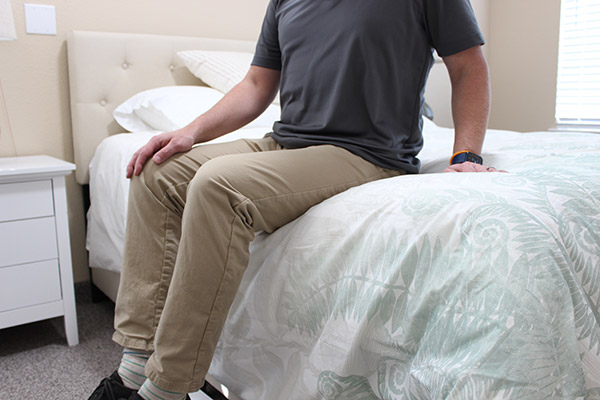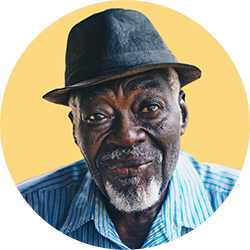Reducing risk in senior living: The top 5 fall prevention tactics you can train in 15 minutes

Post by
Laura Hastings, OTR/L
Director of Clinical Success
One of the most impactful ways to reduce falls and risks in senior living communities is by empowering staff to work proactively and mitigate incidents, creating better outcomes for residents, instead of only reacting to incidents. The key to this culture of fall prevention is effective, efficient training resulting from expert insights. That’s why SafelyYou is sharing our clinicians’—a team of MDs, RNs, OTs, and PTs—top five fall prevention tactics you can train in 15 minutes, based on our analysis of over 100k falls. Our team is the only one in the world who has reviewed this data, making us uniquely qualified to develop these tactics. Below is how you can reduce falls and risk in senior living communities with simple, successful, data-driven training.
The top 5 fall prevention tactics you can train in 15 minutes
The top 5 fall prevention tactics you can train in 15 minutes, which we’ll cover in depth, are:
- Care plan and monitor proper mobility aid placement
- Ensure bed positioning is part of wellness rounding
- Frequently monitor and assess bed height, type, and ability to transfer
- Create a person-centered environment during rounding
- Create an environment that promotes rest
Fall prevention tactic #1:
Reduce risk through care plans and proper mobility aid placement
Common issues with mobility aid placement and falls
In many instances where mobility aids are present and falls occur, we see in our fall videos that the mobility aid is at the bedside, but it’s turned, and a resident with cognitive impairment may be unable to figure out how to manipulate it to use it correctly, so they don’t use it at all. We also see mobility aids placed too close to the bedside, and therefore they become difficult to use, or placed too far from the bedside, and therefore become inaccessible.
What SafelyYou fall video reveals about falls with mobility aids
Our fall video review uncovered the following in falls with mobility aids:
- The wheelchair/walker is unlocked during a transfer
- The resident is not properly seated
- Use of the wheelchair as a walker
- One-handed use of the walker as the resident carries other items
- Walker or wheelchair gets stuck on environmental hazards
- Resident does not see or does not understand how to use the mobility aid
- Not the right mobility aid for the resident’s needs
15-minute fall prevention in-service: mobility aids
With this quick training, your staff will gain clear understanding of how to place mobility aids to help prevent resident falls in your communities.
What you’ll need:
- Resident or model room
- Variety of mobility aids
What you’ll do:
- Discuss proper placement of mobility aids, using the room to demonstrate
- Instruct caregivers to caregivers to place mobility aids in the correct positions at the bedside
- Monitor the following:
- Device is in close proximity of bed and positioned at exit point
- Wheelchairs are locked and placed to promote a safe self-transfer
- Resident has a clear path to exit and navigate the device
Fall prevention tactic #2:
Reduce risk by ensuring bed positioning is part of wellness rounding
Common issues with bed positioning and falls
From our review of fall videos, we often see that the resident is too close to the edge of the bed, and rolls out, with the potential to strike their head on the bedside table. That’s part of why ensuring bed positioning is part of wellness rounding is so critical to reducing risk in your senior living communities.
Proper bed positioning to help prevent falls
To help prevent falls and reduce risk, residents should be positioned in the middle of the bed during wellness rounding. As you can see above, I’m ensuring that our SafelyYou team member, who is in the role of the resident, is centered in the bed and comfortably covered with her blankets. To help keep residents in the center of the bed, you can provide them with visual cues, such as a center pillow in a contrasting color, or physical cues, such as sliding a pool noodle under the fitted sheet.
What SafelyYou fall video reveals about falls involving beds
Our fall video review uncovered the following in falls involving beds:
- Bed is too small for mobility based on resident size
- Is the resident rolling out of bed?
- Bed is too large for the space, creating narrow walking paths
- Is the resident getting stuck on furniture or bedding while walking or transferring?
- Resident is using a new mobility device
- Does bed placement encourage safe use of mobility aids? Have we reevaluated room design since move-in?
15-minute fall prevention in-service: bed positioning
In just 15 minutes, your staff will be empowered to help prevent bedside falls in your communities, with proven tactics that reduce falls and risk.
What you’ll need:
- Resident or model room(s)
- Ideally different bed types
What you’ll do:
- Instruct caregivers to demonstrate proper positioning of the resident to reduce risk of sliding or rolling out of bed
- Have the caregiver gently greet the resident and use verbal and tactile cues for repositioning
- The caregiver should ensure that transfer enablers, blankets, and pillows are placed appropriately to promote comfort and rest
- Properly place fall mat if needed
Fall prevention tactic #3:
Reduce risk by frequently monitoring and assessing bed height and type, and resident’s ability to transfer
Bed height and type, as well as the resident’s ability to transfer, are critical to reducing falls and risk in senior living communities. These factors should be frequently monitored and assessed for fall prevention.
Common issues with bed height and self-transfers in falls
Something we see repeatedly in bed height and self-transfers in falls is that the bed is just too high for the resident, and they are having to climb up onto or slide down from the bed. Another thing to keep in mind is that the bedding is not too slick or overhangs too far.
Proper bed height to help prevent falls and reduce risk

The proper bed height to reduce falls and risk in senior living is one where the resident’s feet are able to easily rest flat on the ground, with their knees aligning with their hips.
15-minute fall prevention in-service: bed height and transfers
Following this short, effective training, your team will be able to successfully evaluate bed height and provide solutions to promote safe transfers, reducing falls and risks in your communities.
What you’ll need:
- Resident or model room
- Variety of mobility aids and examples of transfers enablers (walker, wheelchair, bed cane, transfer pole)
What you’ll do:
- The height of an average bed is 16-25”. Have a caregiver sit on the edge, making sure their hips align with their knees.
- Demo proper height of adjustable beds for wheelchair transfers. Moving from a higher to a lower surface will be easier.
- Observe how a resident would enter or exit the bed when unassisted.
- Discuss how much help staff is providing.
Explain and demonstrate safe use of bed accessories, including bed rails, a cane/halo, and thick vs. beveled edge fall mats
Fall prevention tactic #4:
Reduce risk by creating a person-centered environment during rounding
Environmental factors can contribute to fall risk. SafelyYou data shows that in more than half of falls, the room is cluttered, and in 1 in 4 falls, a closet door is open. But small steps toward creating a more organized, person-centered environment can yield big results for helping to reduce falls and risk.
Common issues with environment and falls

Frequently in fall videos we see that doors to the hallway and doors to the bathroom are nearly indistinguishable, creating confusion and contributing to fall risk.
Environmental solutions to help prevent falls and reduce risk
To help residents determine the correct door to use for the bathroom, consider leaving the bathroom door slightly open or adding a label to it. To further reduce risk, keep personal items easily accessible, and use bedside tables with rounded edges.
15-minute fall prevention in-service: person-centered environment
In minutes, this training will give your staff the knowledge they need to perform an environmental sweep of a resident’s room, helping to reduce falls and risk.
What you’ll need:
- Resident room
- SafelyYou environmental sweep checklist
What you’ll do:
- Demonstrate effective person-centered rounding
- Are personal items easily accessible?
- Is there proper mobility aid placement?
- Is the bathroom readily identifiable?
- Does the resident have proper clothing?
Fall prevention tactic #5:
Reduce risk by creating an environment that promotes rest
How to reduce falls and risk by creating an environment that promotes rest
- Close the door to the resident’s room
- Close the blinds/shades
Turn off the TV - Use motion sensor lights
- Use amber lighting around the bathroom door
- Monitor hallway noise
- Create a clear pathway to the restroom and room exit
- Provide easy access to comfort items
15-minute fall prevention in-service: promoting rest
- Resident room
- SafelyYou resident wellness log
- Discuss and problem solve solutions to promote rest
- Environment
- Daytime engagement
- Med review
- Resident wellness log
1,2,3 Data represents over 3,000 falls from SafelyYou customers.
4,5,6 Data represents over 2,500 on-the-ground events from SafelyYou customers.
7 SafelyYou data from 2021 with over 7,000 detected events






